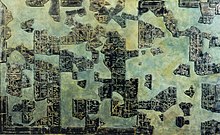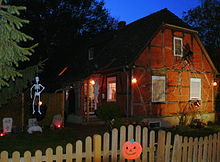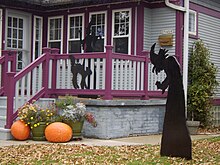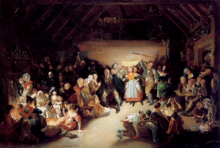Halloween

Halloween (pronounced / hæləwiːn, hæloʊ̯iːn / German also: / hɛloviːn / from All Hallows 'Eve , the night before All Saints') names the folk customs in the evening and the night before the Solemnity of All Saints , October 31, on the first November. This custom was originally widespread mainly in Catholic Ireland . Irish immigrants in the USA cultivated their customs in memory of their homeland and expanded them.
In the course of the Irish renaissance after 1830, a continuity of Halloween customs from the Celtic period and references to pagan and Celtic traditions such as the Samhain festival were assumed in early folklore literature . Corresponding assumptions by the ethnologist James Frazer are cited again and again .
Since the 1990s, US-American Halloween customs have also spread across continental Europe. There are clear regional differences. In German-speaking countries in particular, local customs such as beet spirits or wedding light were mixed with Halloween, and traditional pumpkin growing areas such as Styria and Spreewald quickly picked up on Halloween.
Origin and Etymology
The word Halloween , in older spelling Hallowe'en , is a contraction of All Hallows 'Eve , designating the day before All Saints' Day (as with Christmas Eve , English Christmas Eve ).
Derivation from church history
The history of the origins of the feast day of All Saints goes back to a feast of all holy martyrs, which was celebrated on May 13th, the consecration day of the church Sancta Maria ad martyres in Rome , when Pope Boniface IV. The Pantheon , a temple dedicated to all Roman gods, in Dedicated years 609 or 610 to the Virgin Mary and all the holy martyrs . Pope Gregory III consecrated a chapel in the basilica of St. Peter all saints over a hundred years later and put the public holiday for the city of Rome on November 1st, Gregory IV added this date to the general calendar of Rome .

The reference to Halloween results from the commemoration of All Souls 'day following the celebration of the solemnity of All Saints' Day , on which the Catholics remember their deceased and all poor souls in purgatory through prayer and indulgences . The introduction of All Souls Day on November 2nd goes back to Abbot Odilo von Cluny in 998.
Already in the course of the High Middle Ages and later in the course of the Irish Renaissance , some of the Christian aspects were already projected again onto actual or assumed pagan traditions. The corresponding interaction and associated contradictions are widespread to the present day. In addition, the character of a night of unrest, as well as renewal and spread in several migration movements, are the subject of ethnographic research.
Derived from Celtic or pre-Christian traditions
The anthropologist Sir James Frazer described in his standard work The Golden Bough (in the 1922 edition) Halloween as "an ancient pagan festival of the dead with a thin Christian shell"; In addition to the spring festival Beltane on May 1st ( Walpurgis Night ), it was the second important festival of the Celts. It has been proven since the 8th century when Christian synods tried to abolish such pagan rites.
The Encyclopædia Britannica derives the festival from ancient Celtic customs . The end of summer, when the cattle moved into the stables, was also celebrated on Halloween. It was believed that it was during this time that the souls of the dead returned to their homes. According to the Encyclopædia Britannica, the festival was celebrated with bonfires on hills (English bonfires , literally bonfire ; originally with reference to the burning of the bones of the cattle ) and sometimes disguises that served to drive away evil spirits. Also, fortune telling was common at that date.
The concise dictionary of German superstition , published from 1927 to 1942, writes about November : “The Celts, who counted the year from November onwards, celebrated a great feast of the dead at the beginning of this month, for which the church set the feasts of All Saints and All Souls ”, and about All Souls : “In Celtic areas it was common to light large fires. [...] On the A.tage you can find out what kind of winter will be and how the future - especially in love affairs - will be shaped. [...] Those born in A. (like those born on Christmas Day and in the Twelfth) can see spirits. "
Meyers Konversations-Lexikon writes about the alleged Celtic origin of the festival: “Legendary and historically not to be proven exactly is a direct connection to the Celtic-Anglo-Saxon festival of the god of the dead Samhain. The customs for Halloween should be derived from the connection with this god of the dead, especially the reference to the realm of the dead and spirits. "
Earlier research suspected the oldest reference to the Samhain festival in the difficult to interpret Coligny calendar from the 1st century AD, there as a festival of the end of summer (Celtic samos , Gaelic samhuinn for "summer"), or going back to the irogaelic word for assembly, samain . This assumption is no longer scientifically supported. An alleged god of the dead Samhain cannot be proven historically. Only in much later, medieval writings on the customs of the Celts is reference made to the realm of the dead. These are already strongly influenced by Christianity (see also Celtomania ).
Controversies over the continuity hypothesis
The thesis of a continuous development of Celtic customs into modern Halloween customs is considered outdated and untenable.
Since Ireland is one of the earliest Christianized countries in Europe, for Bernhard Maier a direct continuity to Celtic-pagan rites, which has not been documented anywhere, is unlikely in Ireland and can be ascribed to the Celtic renaissance since the 19th century. (Further approaches can also be found in the article Celts - Reception history .)
The British historian Ronald Hutton sees no evidence for Samhain as a festival of the dead, but emphasizes that the date was certainly a time for the Celtic population in which one had to arm oneself against supernatural forces. The All Saints 'Day and All Souls' Day with the theme of the dead then superimposed the older Samhain festival.
The Austrian ethnologist Editha Hörandner sees the often claimed Celtic or pagan origins as a historical projection that has the character of a seal of approval. Research is less interested in the long-disproved thesis of an unbroken continuity into antiquity, but rather in how the modern yearning for fictional Celtic traditions originates and what is spread from it. The current practice of the festival of Halloween has little or nothing to do with these ideas and is by no means pagan or Celtic. The current development of Halloween as a re-import from the United States is more interesting.
Role as unrest night
Individual aspects of Halloween customs in the countries of origin were already controversial in the early modern era. These included less the mostly Christian primed Heischebräuche but pranks, disturbances and harassment comparable balance other nights like in Central Europe, the Walpurgis Night and New Year following rough nights .
Church Organizations in the UK turned repeatedly against some with Halloween in Related customs, such as the so-called Bonfires (see. Beacon ), and divination . In 1589 the so-called Hallowmas fires were banned in Stirling, Scotland . In 1741 a chronicler from Anglesey noted that the Halloween bonfires were declining there. In 1852, according to the Reverend John M. Wilson's Rural Cyclopedia, Halloween is one of the most important holidays, especially for the rural population in England and Scotland, and is celebrated with great enthusiasm. He laments the "superstitious, pagan and highly reprehensible rites [of the rural people in Scotland], which would offend against common sense, good morals and the Christian religion". In England, however, mostly only harmless jokes ("cheerful merry-making") are organized.
distribution
Halloween was originally only celebrated in areas of the British Isles that remained Catholic , especially Ireland, while the Anglican Church celebrated the Reformation on the day before All Saints Day . With the numerous Irish emigrants in the 19th century, it came to the United States and was part of the tradition of this ethnic group. Because of its appeal, it was soon adopted by the others and became a major popular festival in the United States and Canada .
The custom of setting up pumpkins for Halloween comes from Ireland. According to a legend, there lived the villain Jack Oldfield. He caught the devil with a trick and only wanted to release him if he wouldn't get in Jack O's way from now on. After Jack's death he did not go to heaven because of his deeds, but of course Jack was also not allowed to go to hell because he had betrayed the devil. But the devil had mercy and gave him a turnip and a glowing coal so that Jack could wander through the dark. The lighted pumpkin originated from a lighted turnip, but since pumpkins were available in abundance in the United States, a pumpkin was hollowed out instead. This pumpkin has since been known as the Jack O'Lantern . To scare off evil spirits, grimaces were cut into pumpkins that lit up the courtyard in front of the house.
American Halloween customs spread to Europe during the 1990s, where they have a more cheerful and less gruesome character than in North America. In particular, the failure of the carnival season due to the second Gulf War in 1991 led to increased advertising by the carnival industry for Halloween of the same year. Halloween has been seen in Europe as an occasion for festivals and celebrations that are thematically based on these customs since the early 1990s. The increasing popularity, also in German-speaking countries, has also led to companies taking up the topic by providing thematically appropriate consumer goods such as literature (Halloween cookbooks), costumes, decorations or sweets. Moving around from door to door, the classic “trick or treat”, is a custom that has been picked up in many European, Asian and South American countries as well as in Mozambique , Zimbabwe and South Africa . However, it is practiced almost exclusively on October 31st. In Satanism , the eve of All Saints Day is one of the most important holidays.
character
The Halloween tradition is a mixture of autumn , solvents , Heische- and trim customs . In this sense, it is similar to customs to fair ( Kilbesingen ) to Thanksgiving ( Räbenlicht ) to Martini ( Räbechilbi , martinisingen , martinisingen ), All Saints ( Flenntippln , Rubebötz , Riabagoaschtern ) as well as in the pre-Christmas period ( Bochselacht , Rauhnacht , Anklöpfeln , Andreasnacht , Glowesabend , Sunnerklauslauf ) and on New Year's Eve ( Rummelpottlaufen , Hulken ). There is a certain similarity in the USA to the Mexican customs on the day of the dead .
The most famous custom in North America is that children go from house to house with "Cute or Treat" (shortened: "Trick or treat", English: trick or treat - "String or treat") urging the residents them Giving sweets because otherwise they'll play tricks on them. Disguises are very popular for Halloween. Children and adults alike dress up as fairies, bats, ghosts, witches, pumpkins, skeletons, zombies, dead people, vampires and the like. Typical Halloween colors are black, orange, gray, white, yellow and red. The temporary attacks up to the increased occurrence of arson and property damage in the USA give the Mischief Night on November 1st a similar unrest character as in the Central European custom of the Walpurgis Night .
criticism

As Halloween grew in popularity, criticism came from various quarters. In Germany , there has been criticism that the old customs are increasingly being suppressed, for example martinis singing on November 10 or 11, when songs are sung on the front doors and pastries, fruit or sweets are expected as a reward. Vandalism is also lamented by house graffiti or egg-throwing, which lead to increased police operations on Halloween.
The Solemnity of All Saints , derives its name from the Halloween, heard in some German states to the so-called silent days . In some German states, public entertainment events that do not correspond to the serious nature of these days are prohibited on quiet days .
Evangelical Christians in the United States, in particular , are very far removed from Halloween; they are of the opinion that the festival could lead to abuse by satanist associations and reject Halloween as an occult . Others defend a casual approach to haunted and eerie Halloween by Christians.
Known and controversial in the USA is the temporary construction of so-called Hell Houses , which are often built parallel to Halloween and consist of depictions of eternal damnation, heaven and a corresponding catalog of vices and virtues. Sometimes this leads to unwanted mix-ups with commercial Halloween events.
literature
- Manfred Belok , Manfred Jochum (ed.): Halloween and Christkindl. Festival culture and market. (= Culture and economy. Volume 5). Studienverlag, Innsbruck 2007, ISBN 978-3-7065-4398-9 .
- Markus Dewald : Celts - Pumpkin - Cults. Little cultural history of Halloween. Thorbecke, Stuttgart 2002, ISBN 3-7995-0106-1 .
- Klaus Hock : Halloween. The provocation of a success story. In: Thomas Klie (ed.): Valentin, Halloween & Co. Civil religious festivals in community practice. Evangelische Verlagsanstalt, Leipzig 2006, ISBN 978-3-374-02418-6 , pp. 178–206.
- Marco Höhn: Dead but happy: Halloween - the night of the living dead as an event mix. In: Andreas Hepp , Waldemar Vogelsang (ed.): Popular events - media events, game events, fun events. (= Worlds of experience. Volume 4). Leske and Budrich, Opladen 2003, ISBN SBN 3-8100-3421-5, pp. 205-229.
- Editha Hörandner (Hrsg.): Halloween in Styria and elsewhere. LIT Verlag, Vienna 2005, ISBN 978-3-8258-8889-3 .
- Ronald Hutton: The Stations Of The Sun. A History of the Ritual Year in Britain. Oxford University Press, Oxford 1996, ISBN 0-19-820570-8 (English).
- Gottfried Korff : Halloween in Europe. Keywords for a survey. In: Thomas Thiemeyer, Monique Scheer, Reinhard Johler , Bernhard Tschofen (eds.) Simplicity and meaningfulness. Folklore studies on ritual and symbol. (= Studies by the Ludwig Uhland Institute at the University of Tübingen. Volume 113). Tübinger Vereinigung für Volkskunde, Tübingen 2013, ISBN 978-3-932512-76-6 , pp. 73–86.
- Lisa Morton: The Halloween Encyclopedia. McFarland & Company, Jefferson 2003, ISBN 0-7864-1524-X (English).
- Inge Resch-Rauter: On the trail of the druids. Landscape and stones, festive customs and fairy tales as witnesses to the great European past. Self-published, Vienna 1999, ISBN 3-9500-1671-6 , pp. 287–309.
- Volker Wieprecht , Robert Skuppin : The Lexicon of Rituals. From farewell to cigarette afterwards. Rowohlt, Berlin 2010, ISBN 978-3-87134-684-2 , pp. 96-99.
Web links
- All Hallows' Eve . In: BBC.co.uk (English)
- Halloween . In: History.com (English)
- Halloween . In: Brauchtum.de
Individual evidence
- ↑ Duden editors: Halloween. In: Duden online . January 19, 2013, accessed March 14, 2014 .
- ↑ a b Editha Hörandner: Halloween in Styria and elsewhere. Lit Verlag , Münster 2005, ISBN 3-8258-8889-4 .
- ↑ Daily impulse for November 1, 2014. Archabbey of St. Martin zu Beuron, accessed on November 3, 2014 .
- ↑ Balthasar Fischer: All Saints' Day . In: Walter Kasper (Ed.): Lexicon for Theology and Church . 3. Edition. tape 1 . Herder, Freiburg im Breisgau 1993, Sp. 405 .
- ↑ Halloween. In: britannica.com. October 8, 2018, accessed October 31, 2018 .
- ↑ Kevin Danaher: The Year in Ireland. Irish Calendar Customs. Mercier et al. a., Cork 1972, ISBN 1-85635-093-2 , pp. 190-232.
- ↑ Typical of the 19th century: Whitely Stokes (Ed.): Cormac's glossary. = Sanas Chormaic. Translated and annotated by John O'Donovan. Irish Archaeological and Celtic Society, Calcutta 1868.
- ↑ On the problem of religious historical derivation from Celticism compare: Bernhard Maier : The religion of the Celts. Gods, myths, worldview. 2nd revised edition. Beck, Munich 2004, ISBN 3-406-48234-1 , p. 174 ff.
- ↑ Alois Döring: "... and lit fires on hills". (PDF, 92 kB) September 2001, archived from the original on November 5, 2001 ; accessed on March 17, 2014 .
- ↑ No “trick or treat” with Salzburg's Celts. (No longer available online.) In: Salzburger Nachrichten . October 29, 2010, archived from the original on March 17, 2014 ; accessed on March 17, 2014 (Stefan Moser, head of the Celtic Museum in Hallein in a newspaper interview on the alleged continuity of Halloween).
- ↑ Bernhard Maier: The religion of the Celts. Gods, myths, worldview. 2nd revised edition. Beck, Munich 2004, ISBN 3-406-48234-1 , p. 178. "What is considered typically Celtic today is in many cases just a product of modern or even ancient Celtic ideology."
- ↑ see: Hutton: The Stations Of The Sun. 1996, p. 370.
- ↑ Hutton: The Stations Of The Sun. 1996, p. 366.
- ↑ John M. Wilson (Ed.): The Rural Cyclopedia, or a General dictionary of agriculture, and of the arts, sciences, instruments, and practice, necessary to the farmer, stockfarmer, gardener, forester, landsteward, farrier, & c. Volume 1: A-C. Fullarton & Co., Edinburgh 1852, p. 120.
- ↑ Werner Müller, Helmut Achatz: Creepy good business. In: focus.de . October 30, 2006, accessed March 17, 2014 .
- ↑ Julia Bonstein: Halloween: Trick or Treat? In: Spiegel Online . October 19, 2010, accessed March 17, 2014 .
- ↑ Color trend 2018 The Germans and their forest green Deutschlandfunk January 2, 2018
- ^ Gottfried Korff: Halloween in Europe. Keywords for a survey. In: Journal of Folklore. Volume 97, Issue 2 (2001), pp. 177-189.
- ^ Anton Szandor LaVey : The Satanic Bible. Index Verlag, Zeltingen-Rachtig 2007 (1969), ISBN 978-3-936878-05-9 , p. 112.
- ↑ Daniel Boss: Viersen: Police are dreading Halloween. In: Westdeutsche Zeitung . October 24, 2008, accessed March 18, 2014 .
- ↑ Holidays in Bavaria. (No longer available online.) In: Bavarian State Ministry of the Interior, for Building and Transport . Archived from the original on March 18, 2014 ; accessed on March 18, 2014 . Info: The archive link was inserted automatically and has not yet been checked. Please check the original and archive link according to the instructions and then remove this notice.
- ↑ Billye Dymally: Halloween. Satan's New Year. Infinity Publishing, West Conshohocken PA 2006, ISBN 0-7414-3387-7 . Kele Gershom: Halloween. Counterfeit Holy Day. Fisherman Publishing, sl 2005, ISBN 0-9772425-0-1 . Steve Russo: Halloween. What's a Christian to Do? Harvest House Publishers, Eugene OR 1998, ISBN 1-56507-851-9 .
- ↑ Lint Hatcher: The Magic Eightball Test. A Christian Defense of Halloween and All Things Spooky. Self-published, Lulu Press 2006, ISBN 1-84728-756-5 .








